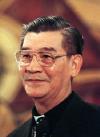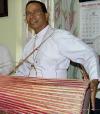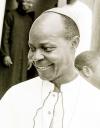|
Issue Date: October 10, 2003 New cardinals surprisingly diverse Pope defies expectations of stacking the deck with conservatives in group to elect successor By JOHN L. ALLEN JR. Defying expectations that he would stack the deck by appointing a slate of conservatives, John Paul II shook up the politics surrounding the election of his successor Sept. 28 by announcing a surprisingly diverse group of 31 new cardinals. The cardinals’ red hats will be distributed Oct. 21 in a consistory in Rome. The new princes of the church range from strong conservatives such as George Pell of Sydney, Australia, and Justin Rigali, recently appointed to Philadelphia, to relative progressives such as Keith Michael Patrick O’Brien of St. Andrews, Scotland, and Stephen Hamao, a Japanese archbishop currently heading the Vatican’s office for migrants and refugees. For Americans, the Sept. 28 appointments suggest that from the Vatican’s point of view, the worst of the recent sexual abuse crisis is over. John Paul chose ecclesiastical business as usual with the nomination of Rigali, a longtime Vatican loyalist, over Sean O’Malley of Boston, the archdiocese that is the symbol of the tumult in American Catholicism. Only 25 of the 31 appointees announced Sept. 28 immediately become electors for the next pope. Four are priests already over 80, and one new cardinal is to be created in pectore, meaning secretly, and hence it’s impossible to know if he will be eligible to vote for the next pope. An NCR analysis suggests that of the 25 new electors, only seven are doctrinal conservatives whose primary interest lies in intra-church debates. Aside from Pell, 62, and Rigali, 68, this group includes new cardinals Tarcisio Bertone, 68, of Genoa, Italy; Marc Ouellet, 59, of Quebec; Oscar Scheid, 70, of Rio de Janeiro; Philippe Barbarin, 53, of Lyon, France; and Angelo Scola, 61, of Venice, Italy. Even within this group, there is a surprising range of opinion on some issues. Scheid, for example, is traditional on doctrinal debates, but unpredictable enough on social questions to support decriminalization of drug use. Barbarin is known primarily as an evangelist rather than a doctrinal “enforcer.”
Meanwhile, six of the new cardinals are doctrinal moderates generally sympathetic to reforms such as decentralization of power and greater freedom for theological debate. In addition to O’Brien, 65, and Hamao, 73, this block includes: Jean-Baptiste Pham Minh Man, 69, of Vietnam; Bernard Panafieu, 72, of Marseilles, France; Francesco Marchisano, 74, an Italian who is the archpriest of St. Peter’s Basilica; and Ennio Antonelli, 66, of Florence, Italy. Many church observers felt O’Brien had spoiled his chances of becoming a cardinal with a famous interview at the time of the 1999 Synod for Europe, in which he complained about curial manipulation of the synod process. Recently he has also expressed openness to doing away with mandatory clerical celibacy. “The loss of celibacy would give great liberty to priests to exercise their God-given gift of love and sex rather than feeling they must be celibate all their lives,” O’Brien said in a newspaper interview. “It would not cause me any great worry if it was to go.”
The largest single group in the new roster of cardinals is composed of men whose primary interest is in social justice questions outside the church, where they take a moderate-to-progressive stance. They include: Jean-Louis Tauran, 60, currently the Vatican’s foreign minister; Renato Martino, 70, president of the Pontifical Council for Justice and Peace; Anthony Olubunmi Okogie, 67, Lagos, Nigeria; Josip Bozanic, 54, Zagreb, Croatia; Gabriel Zubeir Wako, 62, Khartoum, Sudan; Telesphore Placidus Toppo, 64, Ranchi, India; Rodolfo Quezada Toruno, 71, Guatemala; Carlos Amigo Vallejo, 69, Seville, Spain; Peter Erdo, 51, Budapest, Hungary; and Peter Kodwo Appiah Turkson, 55, Cape Coast, Ghana.
Meanwhile, three new cardinals embody an old-school form of traditionalism that seeks to translate church teaching quasi-automatically into social policy. They are: Julian Herranz, 73, a Spaniard who heads the Pontifical Council for the Interpretation of Legislative Texts; Javier Lozano Barragan, 70, of Mexico, president of the Pontifical Council for Health Care; and Attilio Nicora, 66, Italy, prefect of the Administration of Patrimony of the Holy See. Other points of interest relative to the new cardinals include their age, their geographic spread and the elevation of several men with personal experience of Islam. In terms of age, the Oct. 21 consistory will produce the four youngest cardinals in the world: Erdo, Barbarin, Bozanic and Turkson. Also under 60 is Ouellet of Quebec. Since cardinals retain their right to vote for the next pope and to sit on the congregations and councils of the Holy See until they reach 80, even if they resign as diocesan archbishops, these men are positioned to be important power brokers for at least the next 20 years. Geographically, John Paul has continued the custom of trying to ensure a roughly equal distribution of red hats around the Catholic world. Thirteen of the 25 new voting cardinals are from Europe, three are from Latin America, two from North America, three from Asia, one from Oceania, and three from Africa. Toppo is the first aboriginal Indian to be named a cardinal. There are some 3 or 4 million aboriginal Christians in India, who, sources say, are being courted intensely by fundamentalist Hindus. Toppo, regarded as traditional, quiet and middle-of-the-road theologically, is said by sources in Rome to be a strong exponent of liberation for the millions of tribal peoples of Asia. As for Islam, four of the new cardinals come from dioceses with significant Muslim populations: Okogie of Nigeria, Panafieu of Marseilles in France, Zubeir of Sudan, and Amigo Vallejo of Seville in Spain. Panafieu is the president of the French bishops’ commission on relations with Islam, and has a reputation as an advocate of tolerance in inter-religious dialogue. Okogie is the president of the Christian Association of Nigeria, the primary interdenominational group that has responded to growing Islamic fundamentalism in Nigeria’s northern states. As archbishop of Tangiers from 1973 to 1982, Amigo Vallejo oversaw the establishment of diplomatic relations between the Holy See and Morocco, and took part in a Christian-Islamic dialogue sponsored by the Vatican and the Libyan government. Zubeir has resisted the “Islamization” of the southern Sudan, where the 10 percent of the population that is Christian is concentrated. The introduction of four men with expertise on Islam into the college may respond to the widely held view among cardinals that among the most important challenges facing the next pope will be the dialogue with the Muslim world. Popes typically name a cardinal in pectore when there is some reason that would make releasing his name problematic. Speculation in Rome has focused on two names: Stanislaw Dziwisz, the pope’s personal secretary, whose appointment as a cardinal would break precedent; or Archbishop Joseph Zen of Hong Kong, whose criticism of the Chinese government has made him a controversial figure. Herranz’s appointment raises to two the number of Opus Dei cardinals. The other is Cardinal Juan Luis Cipriani of Lima, Peru. Many American Catholics had expected O’Malley to be among the batch of new cardinals named Sept. 28, as an expression of John Paul’s solidarity with Boston as a symbol of the crisis in American Catholicism. The U.S. church already had 13 cardinals relative to its 65 million Catholics, however, meaning it was arguably overrepresented. By way of comparison, Brazil had 139 million Catholics and just seven cardinals. The four honorary cardinals, priests over 80 rewarded for special service to the church, are: Fr. George Cottier, Switzerland, the pope’s personal theologian; Msgr. Gustaaf Joos, Belgium; Fr. Thomas Spidlik, Czech Republic; and Fr. Stanislaw Nagy, Poland. Most Vatican observers had expected a consistory in February 2004, and some have speculated that the pope’s declining physical condition prompted the decision to move things up. Vatican sources tell NCR, however, that the basis for the shift was logistical. All the cardinals of the world were already expected in Rome in October for the pope’s 25th anniversary and for the beatification of Mother Teresa, and many expressed a wish not to have to return just four months later. John L. Allen Jr. is NCR Rome correspondent. His e-mail address is jallen@natcath.org.
National Catholic Reporter, October 10, 2003 |


